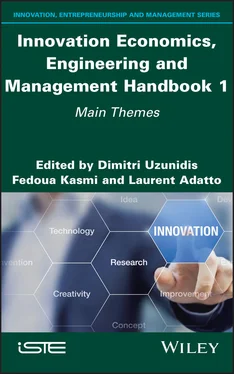In sociology, several research communities are documenting these evolutions of the notion of innovation. The work of Chambers et al . (1989) and Darré et al . (1989), in particular, paves the way to research that restructures local empirical knowledge and endogenous innovation. They shift the analysis from categories (researchers, farmers, etc.) to local networks of actors structuring collective innovation capacities. Other research brings a consideration of the history and the institutional context that determine technical and organizational changes into the analysis (Chauveau et al . 1999).
This emergence contributes to the development of a new approach to producing knowledge and innovation on living organisms, with a view to promoting varietal innovation, which has been disrupted by societal controversies on genetically modified organisms. At another level, analysis of the role played by the evolution of technical systems, such as agro-ecology and social structures, according to organizational scales, questions the theoretical frameworks for analyzing transitions.
The analysis of innovation in, or related to, the agricultural sector thus prompts new disciplinary collaborations in order to integrate the role of institutions, networks or knowledge. These collaborations underline the importance of local context for social innovations: sustainable nutrition and/or territorial development thus contribute to the renewal of work on innovative environments and local productive systems.
3.5. Sector specificities of innovation in agriculture and food
The meaning given to innovation in the field of agriculture therefore takes into account, in part, the specificities of agricultural activity itself: geographical diversity, diversity of sectors, diversity of types of farming: family, entrepreneurial, organizational (cooperatives), etc. Innovation refers to different forms of processes that structure the implementation of technical, institutional and organizational changes and their systemic interactions. Using the term “agricultural innovation” questions whether agriculture as an activity of exploitation of natural ecosystems specifies innovation processes or whether it doesn’t. Therefore, we can propose three axes of differentiation of these specificities, in biophysical, socio-economic or organizational dimensions.
The biophysical dimension concerns the dependence of innovation processes (conditions of emergence, adoption and deployment) on the increasing instability of climatic variables affecting the activity. It also relates to the biological and therefore living dimension of agricultural products. These two attributes determine the instability variables of technical processes (production, conservation) that generate risks and, therefore, collective strategies (coordination, contracts) to regulate these risks. However, in the economic sense, the introduction of this risk factor is an intrinsic reality of innovation.
The second dimension refers to the specificities of the agricultural production function linked to the weakness of economies of scale in agriculture. It is partly explained by a lower rate of return on capital investment than in other sectors. It refers to social structures of production that are still predominantly based on fragmented modes of production using family labor, even if certain forms of agro-industrialization are necessary in certain sectors governed by industrial processing activities such as ripening facilities and the food processing industry.
This limited profitability, due to the structuring of agricultural activity, leads the public authorities to compensate for its shortcomings through public investment in agronomic research, which creates a dynamic dedicated to the governance of innovation that is exogenous to agrarian societies. Thus, even if they do not oppose each other, innovations of an endogenous (induced by farmers and actors themselves) and exogenous (driven by public authorities and other institutions) nature have specific proportions in agriculture. Finally, some cross-cutting innovations (technological, genetic, digital) are the result of inter-organizational and supranational collaborations and require long cycles of diffusion and appropriation.
Finally, agricultural innovation is specific because of the multifunctional nature of the resources it uses, mainly land and water, which have non-market identity heritage functions. These territorially anchored production “factors” make certain agricultural innovations difficult to generalize or transpose from one territory to another.
In economics and sociology, the analysis of change in agriculture, including food, is part of the shifting history of technical progress towards different forms and meanings of innovation. The territorial anchoring of innovation highlights the importance of debates and controversies concerning the modification of living things, food security and agro-ecological transition. Innovation becomes an intermediate object that allows the construction of interdisciplinarity between economics and sociology by associating management, geography and agronomy.
The three dimensions that specify innovation processes in agriculture and food explain the dedicated needs for the coordination of economic agents and, therefore, the forms of professional organizations and regulatory institutions (biosafety standards, quality labels) that structure sectoral policies. Recently, agricultural innovation has been doubly challenged by the convergence of two issues: that of ecological transitions allowing for the management of the renewal conditions of ecological resources that determine the equilibrium of ecosystems and, thus, of biological and human life in an inclusive manner, and that of the acceleration of sciatic and technical progress in biotechnologies and digital technologies, which structure both the technological promises and the societal risks associated with their conditions of realization.
Boserup, E. (1981). Population and Technological Change: A Study of Long-Term Trends . The University of Chicago Press, Chicago.
Chambers, R., Pacey, A., Thrupp, L.A. (1989). Farmer First: Farmer Innovation and Agricultural Research . The Bootstrap Press, New York.
Chauveau, J.-P., Cormier-Salem, M.-C., Mollard, E. (1999). L’innovation en agriculture, questions de méthodes et terrains d’observation . IRD Éditions, Paris.
Chiffoleau, Y. and Touzard, J.-M. (2014). Understanding local agri-food systems through advice network analysis. Agriculture and Human Values , 31(1), 19–32.
Darré, J.-P., Le Guen, R., Lémery, B. (1989). Changement technique et structure professionnelle locale en agriculture. Économie rurale , 192–193, 115–122.
Faure, G., Toillier, A., Mathé, S., Triomphe, B., Temple, L. (2019). Evaluación de los sistemas de innovación agropecuaria para el diseño de políticas públicas: una revisión de la literatura. In Sistemas y políticas de innovación para el sector agropecuario en América Latina , Goulet, F., Le Coq, J.-F., Sotomayor, O. (eds). E-papers, Rio de Janeiro.
Jas, N. (2005). Déqualifier le paysan, introniser l’agronome, France 1840–1914. Écologie & politique , 2(31), 45–55.
Joly, P.B. (2001). Les OGM entre la science et le public ? Quatre modèles pour la gouvernance de l’innovation et des risques. Économie rurale , 266(1), 11–29.
Klerkx, L., Aarts, N., Leeuwis, C. (2010). Adaptive management in agricultural innovation systems: The interactions between innovation networks and their environment. Agricultural Systems , 103(6), 390–400.
Labini, P. (2007). Développements scientifiques, innovations technologiques, croissance et productivité. Revue d’économie industrielle , 118, 79–90.
Читать дальше












